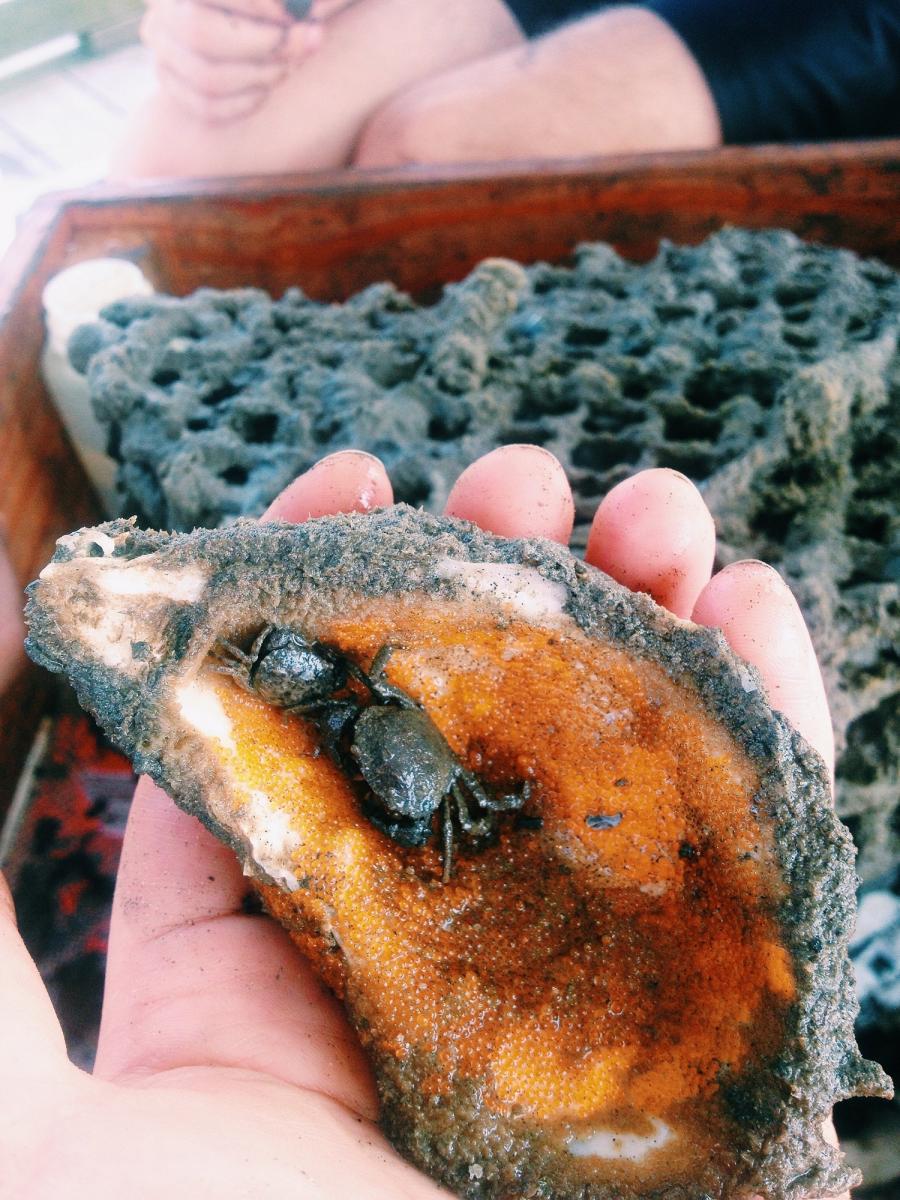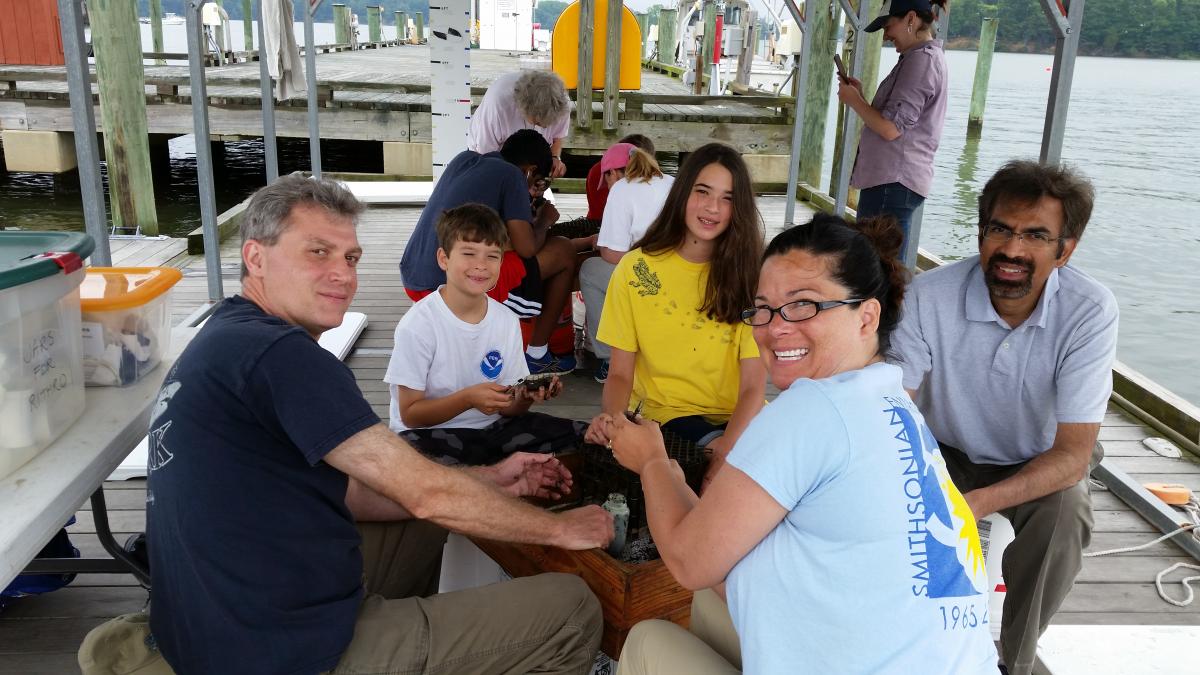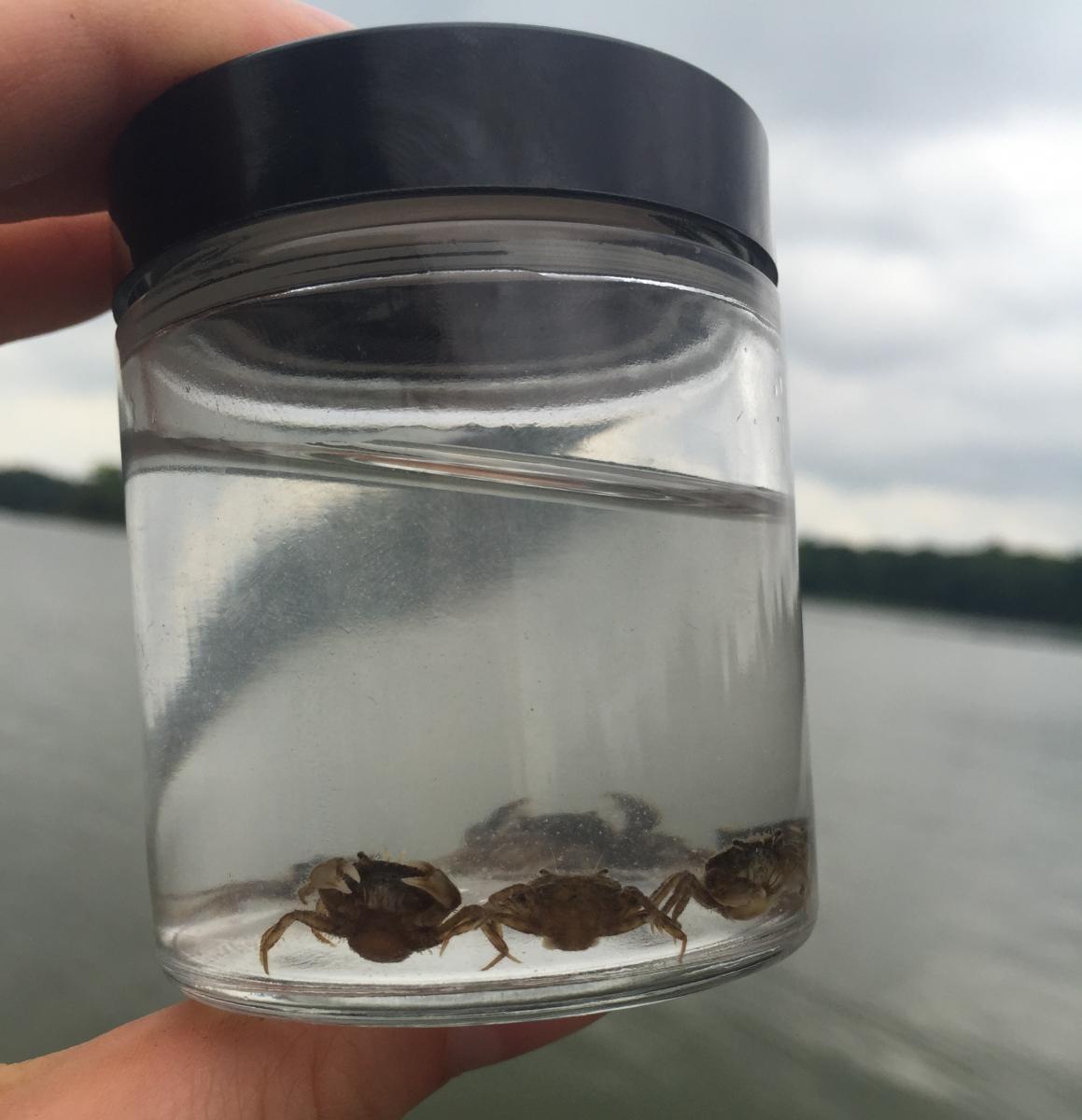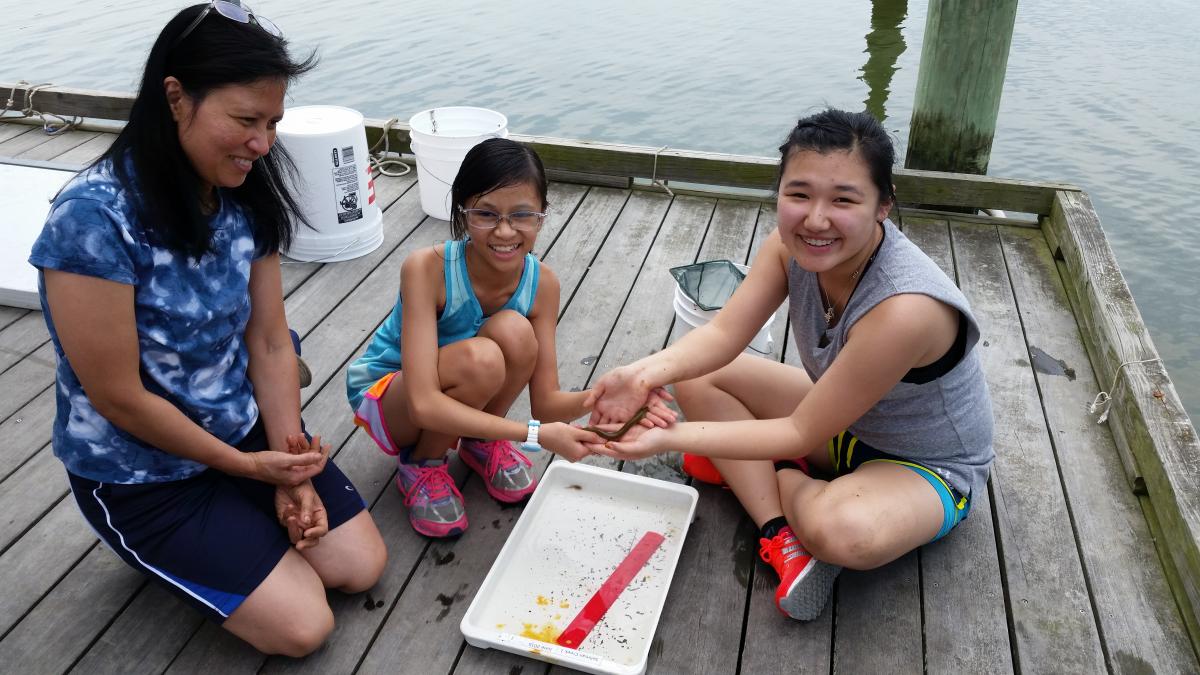Chesapeake Bay Parasite Project
About the Project
White-fingered mud Crabs (Rhithropanopeus harrissi) are native to the Chesapeake Bay. These scavengers are small, and live in oyster reefs and woody debris in the water. Mud crabs typically live less than 2 years, which means they don’t have a long time to reproduce. The parasitic barnacle that infects these mud crabs is called Loxothylacus panopaei (Loxo, for short). Loxo infects and castrates the crabs, which means they can no longer reproduce. Loxo is an invasive species, which means that they have been transported from their native home and harm the ecology and economy of their new environments. Not all foreign species are invasive, and some get along very well with new neighbors. Loxo, however, is aggressive. Loxo takes control of the crab and changes major functions like molting and reproduction. The infected crabs have been nicknamed "Zombie Crabs" as a result. When the crabs are infected, the parasite produces a sac-like growth on the abdomen of the crabs. These sacs are the reproductive bodies of the parasite. The sacs are filled with thousands of eggs that are fertilized by a male Loxo attached to the inside of the sac. The resulting larvae are then released into the water to seek a new crab host. Both male and female crabs can be parasitized, and both are tricked into caring for the larvae of the parasites.
Mud crabs are an important part of the Chesapeake Bay, they are important predators that play a key role in the food web structure of this ecosystem. They may also be an indicator species, which means that the health of their population is a direct reflection of the health of their habitat, which includes oyster reefs. Scientists want to know how Loxo affects the mud crab population—are mud crab populations steady? Or are they declining because Loxo does not let them reproduce? They will find the answer to this question by studying
- Size of the crab
- Sex of the crabs
- Presence or absence of outward signs of the Loxo parasite.
History of Loxo
Loxo are native to the Gulf of Mexico, the Caribbean, and parts of Florida, Mud crabs are easily transported with oysters, and Loxo was most likely transported to the Chesapeake with mud crabs in shipments of oysters from the Gulf of Mexico. Sometimes people intentionally bring a new species into an area, without realizing the harm it or its parasites can do to the environment. The parasite is now common in the Bay, but the population and abundance varies greatly between years, and scientists are still trying to figure out why these fluctuations happen.
Scientists at SERC have been studying Loxo since the early 1990’s! Starting in 2003, scientists have collected mud crabs every summer.
The "What" and the "Why"
What are we trying to learn?

We want to know where Loxo are spreading throughout the Chesapeake Bay. If we can see patterns in where Loxo is, then we can try to understand why they like a particular area. This can also help us understand why the patterns vary from year to year. If we find Loxo at a site, it is less likely that there will be smaller, baby crabs there because Loxo prevents crabs from reproducing.
When we collect crabs, we also collect information about temperature and salinity to help scientists understand Loxo’s survival and growth. Do particularly warm winters encourage spread? On the other hand, do particularly cold winters kill off Loxo? We want to know if temperature, and fresh water (or salt water) have an effect on Loxo’s prevalence. Prevalence is the proportion of a population that exhibits a certain trait, which, in this case is the number of crabs infected by Loxo.
In our search for Loxo we also assess mud crab populations and gather data that can be used to to find out if fluctuations in mud crab populations are driven by Loxo or by other factors? To learn more about how we do this, visit our methods (hyperlink) page.
Why do we care about Loxo? Why do we care about mud crabs?

Mud crabs are too small to eat or sell—so why do we care about them? Well, they’re still a part of the Chesapeake Bay ecosystem! Removing their population entirely would be bad for animals that feed on the mud crabs such as birds, fish, and larger crabs. But mud crabs are also important predators themselves and are key to the health of their habitat, which include oyster reefs and marshes. Losing them would upset the delicate balance of the ecosystem.
But, there is also another reason: A similar barnacle, Loxothylacus texanus, is infecting blue crabs in the Gulf of Mexico. If it spreads, L. texanus could cause the collapse of the entire multi-million-dollar blue crab fishing industry in Chesapeake Bay. SERC scientists hope that by understanding the effect of Loxo (Loxothylacus panopaei), they can better prepare in case its cousin ventures north.
Masterminding the Takeover
Magic all magic
Methods
Scientists have picked sites based on historic data and the generosity of private landowners who have allowed us long-term access to their docks and marinas. Each June and August we process over 60 traps from a variety of locations.
We sample in June and August, during the breeding season. We started sampling twice to look at recruitment and reproduction of the crabs.
At each site, scientists collect environmental data (things like temperature and salinity). The crabs are collected in crates filled with oyster shells. These are not traps—the crabs (and eels and fish) can go in and out as they please. The crabs take up residence in the cracks and crevices of the shells. When we pull up the crates, we dump the contents in sieves, and hand-collect every single crab from every shell for further study. Some of the crabs are really small--no bigger than a tick!
After we have found all of the crabs in their “crab condos,” we put the now uninhabited shells back into the crates and into the water. We do two rounds of collection in the summertime (June and August).

We want to make accurate inferences about the crab and parasite populations at the sites, so we need to make sure that we collect all the crabs in the crab condos. Participants split into teams, and after they have gone through the traps once, they switch sieves, and do one more round called a verification round. This is when different sets of eyes go through all of the shells in the crate one more time to look for any crabs that the first team missed. The crabs that were overlooked are placed in a separate bottle, so we can record the number and size of the missed crabs back in the lab.
Get Involved
We could not get to nearly as many sites or have as large of a dataset without help from committed volunteers! Without you, it would be very hard for us to study the spread of Loxo throughout the Chesapeake Bay. In our lab we have two big field survey events in June and August, and have lab opportunities from October to May.
Eligibility and Time Commitment
No training is required for either the field surveys or lab opportunities—all training is provided!
Field Surveys:
- We typically ask volunteers to join us our field survey for about 4 hours in the morning.
- Volunteers must be at least 14 years old to help out with the field activities.
- Volunteers under the age of 16 must be accompanied by a participating adult.
Lab Opportunities:
- We occasionally have open opportunities to work in the lab processing samples under the microscope.
- Volunteers must be at least 16 years old.
- Volunteers must be able to join us for at least two hours one day per week for two months.
Location and Days/Times
Field Surveys:
- Field sampling days vary from year to year, depending on when we put out the traps.
- We do two rounds of big data collection—usually in mid-June, and mid-August.
- For most field sampling days, volunteers meet the research team at the SERC Dock in Edgewater, MD.
- A few field sampling days welcome volunteers in other parts of the Bay (for example, in Oxford and Broomes Island, Maryland).
Lab Opportunities:
- There are opportunities in the lab for volunteers who want to sort through crabs for Loxo presence using microscopes.
- We typically have openings from October to May (we don't normally take new people in the summer due to our busy field schedule).
- Volunteers come in at least two hours per week (Monday to Friday only).
Sign up to volunteer
August sampling dates are up! Sign up to join us outside and look for mud crabs in our sampling crates.
Interested in being a part of the field surveys? Sign up for the Participatory Science eNews, where the sampling dates will be announced.
Want to join us in the Lab? If you are at least 16 years old, please contact Rachael Mady, SERC's Participatory Science Coordinator, at MadyR@si.edu.
August 2023 Mud Crab Sampling
August 2023 Mud Crab Sampling
Look for mud crabs with the Chesapeake Bay Parasite Project!

Help us find mud crabs so that we can learn more about how an introduced parasite (Loxothylacus panopaei or Loxo for short) is affecting them. Loxo is a parasitic barnacle that takes over the nervous system of affected mud crabs and makes the crab care for the parasite and the parasite's larvae.
Loxo is native to the Gulf of Mexico and the Caribbean and was first discovered in Chesapeake Bay in 1964. The parasite is now common in the Bay, but its abundance and spread vary greatly from year to year. Scientists in SERC's Marine Invasions Lab have been tracking the abundance of Loxo from sites around Chesapeake Bay since 2003 (watch a short video that features the project’s scientists).
Where?
Edgewater, MD (SERC dock)
August 6th, 15th, 17th, and 20th
St. Leonard, MD (Len’s Marina)
August 8th
Oxford, MD (NOAA Cooperative Oxford Laboratory)
August 9th
Please note that transportation to Oxford and St. Leonard will not be provided.
For those who register, you will receive additional details (including directions, what to wear, what to bring, and a safety overview) in an email two days before the event.
Time?
We will be sampling 9:00 AM – 3:00 PM.
The end time (3 PM) is the maximum time a session will last, and we may end earlier depending on the number of crabs in the collectors.
Who can participate?
We welcome volunteers age 12+, although all volunteers under the age of 16 must be accompanied by a participating adult. Volunteers younger than 12 may be accepted on a case-by-case basis. All volunteers (including accompanying adults) must be included in the sign up.
No prior experience is expected or required. The project researchers will provide training day-of and will be there to answer all your questions.
August 2024 Mud Crab Sampling
August 2024 Mud Crab Sampling
Look for mud crabs with the Chesapeake Bay Parasite Project!

Help us find mud crabs so that we can learn more about how an introduced parasite (Loxothylacus panopaei or Loxo for short) is affecting them. Loxo is a parasitic barnacle that takes over the nervous system of affected mud crabs and makes the crab care for the parasite and the parasite's larvae.
Loxo is native to the Gulf of Mexico and the Caribbean and was first discovered in Chesapeake Bay in 1964. The parasite is now common in the Bay, but its abundance and spread vary greatly from year to year. Scientists in SERC's Marine Invasions Lab have been tracking the abundance of Loxo from sites around Chesapeake Bay since 2003 (watch a short video that features the project’s scientists).
Where?
Edgewater, MD (SERC dock)
August 3rd, 5th, 10th, 14th
Broomes Island, MD
(Len's Marina)
August 12th
Oxford, MD
(NOAA Cooperative Oxford Laboratory)
August 6th
Please note that transportation to Oxford and Broomes Island will not be provided.
For those who register, you will receive additional details (including directions, what to wear, what to bring, and a safety overview) in an email two days before the event.
Time?
The sampling time varies by day depending on how many traps the team is planning on processing.
The end time varies and is the maximum time a session will last. We may end earlier depending weather conditions and on the number of crabs in the collectors.
Who can participate?
We welcome volunteers age 14+, although all volunteers under the age of 16 must be accompanied by a participating adult.
Volunteers younger than 14 may be accepted on a case-by-case basis. All volunteers (including accompanying adults) must be included in the sign up.
No prior experience is expected or required. The project researchers will provide training day-of and will be there to answer all your questions.